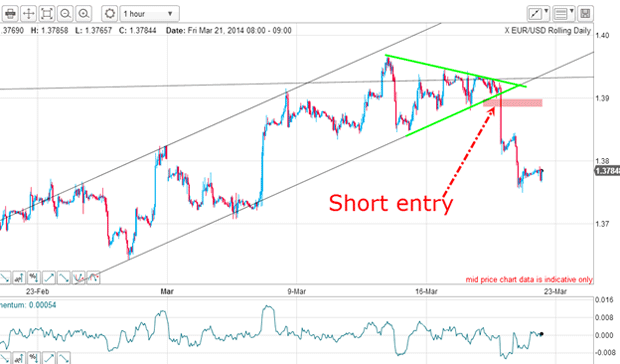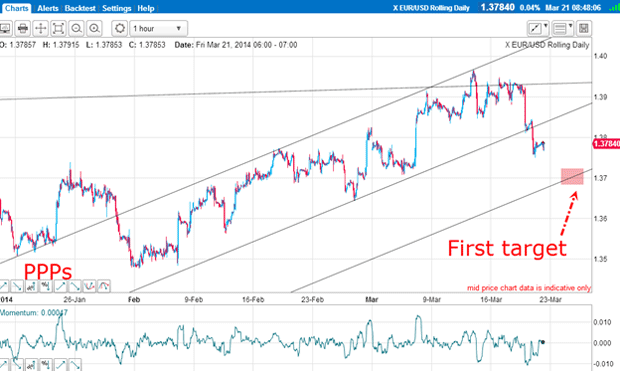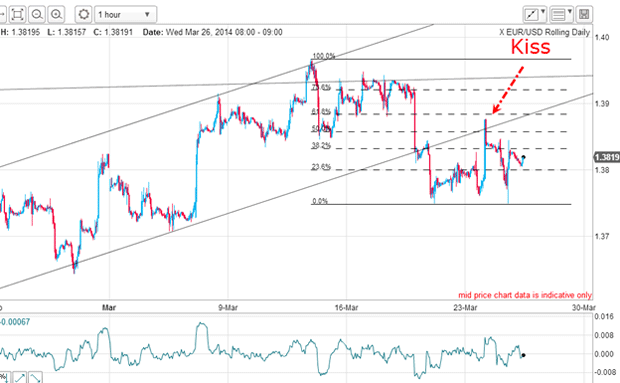The simple way to find low-risk trades
If you can spot the trend-change early on, a low-risk trade is yours for the taking. John C Burford explains how it's done.
When I covered the EUR/USD last Friday, I noted that the market had rallied to my line in the sand' just above the 1.3950 area on 13 March. Since then, the market has been edging down - but not before making a traditional kiss on my lower tramline.
So today, I want to show you how you can use a tramline kiss to make a low-risk trade. This is especially useful if you have missed the first opportunity.
Keep an eye out for this tradable event
But even before this stage was reached, I had an excellent short entry based on my smaller-scale tramline pair:
MoneyWeek
Subscribe to MoneyWeek today and get your first six magazine issues absolutely FREE

Sign up to Money Morning
Don't miss the latest investment and personal finances news, market analysis, plus money-saving tips with our free twice-daily newsletter
Don't miss the latest investment and personal finances news, market analysis, plus money-saving tips with our free twice-daily newsletter

As noted, the downward break of the triangle (outlined in green) in conjunction with the lower tramline break combined together to give me my trade signal. And a close protective buy-stop could be placed just above the upper green line, giving a low-risk trade. Remember, I am only interested in low-risk trades.
If I have a possible trade where a logical stop would be too far away, I refuse it. I suggest you adopt the same strict policy.
With the move lower, I then searched for a larger-scale tramline pair. This is what I found:

The tramline pair I found was very satisfactory, with the PPPs (prior pivot points) on the upper line. The gradually sloping line is my line in the sand. Recall this line is two years old and represents major resistance. This is why I expected the trend to change from up to down.
How to know when the trend will change
But if you can recognise a likely trend change early, then you have a low-risk trade. Why low-risk? Because if the trend has not changed, the market will move up and take you out for a small loss.
Remember, I am only interested in small losses.
So is there another low-risk opportunity now that the market has moved lower and has likely confirmed a trend change?

Since Friday, the market stabilised and moved up and made a kiss on the lower tramline. In fact, there was a slight overshoot as the market had a knee-jerk reaction to the news that the European Central Bank was not ruling out instigating a quantitative easing (QE) operation of its own. Such a development would likely be bearish for the euro.
Here's the reason why I trade the spikes
The kiss ended just shy of the Fibonacci 62% level, which is the most common level where turns occur. The market was battling the very strong resistance of the lower tramline with the natural rallying tendency to reach the 62% level.
This tug-of-war action is common at such volatile times. That was why I was not surprised the market missed the ideal turning point.
In any case, the spike up and down was over in just a few minutes and this illustrates my strategy for trading these spikes.
After a tramline break and if I anticipate a kiss, I will enter a resting limit order and my stop level before the hoped-for event. That removes the necessity of continually staring at my screen, which is normally a distracting habit anyway.
And the best part is that now I have a second low-risk entry.
Get the latest financial news, insights and expert analysis from our award-winning MoneyWeek team, to help you understand what really matters when it comes to your finances.
John is is a British-born lapsed PhD physicist, who previously worked for Nasa on the Mars exploration team. He is a former commodity trading advisor with the US Commodities Futures Trading Commission, and worked in a boutique futures house in California in the 1980s.
He was a partner in one of the first futures newsletter advisory services, based in Washington DC, specialising in pork bellies and currencies. John is primarily a chart-reading trader, having cut his trading teeth in the days before PCs.
As well as his work in the financial world, he has launched, run and sold several 'real' businesses producing 'real' products.
-
 Top 10 locations for buyers and renters revealed
Top 10 locations for buyers and renters revealedLondon is crowned as the most popular location for renters and buyers, despite rising costs. But where else are house hunters heading to?
-
 Making financial gifts to loved ones? Write it down or risk giving an IHT bill too
Making financial gifts to loved ones? Write it down or risk giving an IHT bill tooGiving gifts can be a way to pass on wealth and reduce the inheritance tax bill on your estate but do it wrong and you could leave family and friends more than they bargained for.